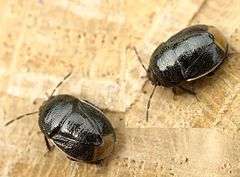Canthophorus dubius
Canthophorus dubius is a species of burrowing bugs or negro bugs belonging to the family Cydnidae, subfamily Sehirinae.
| Canthophorus dubius | |
|---|---|
| Canthophorus dubius, upperside | |
| Side view | |
| Scientific classification | |
| Kingdom: | |
| Phylum: | |
| Class: | |
| Order: | |
| Suborder: | |
| Infraorder: | |
| Superfamily: | |
| Family: | |
| Subfamily: | |
| Genus: | |
| Species: | C. dubius |
| Binomial name | |
| Canthophorus dubius (Scopoli, 1763) | |
| Synonyms | |
| |
Distribution
This palearctic species is widespread in most of Europe, in Asia and in North Africa.[1]
It was found in Albania, Algeria, Austria, Belgium, Bosnia and Herzegovina, Bulgaria, Croatia , Cyprus, Czech Republic, Egypt, Finland, France, Germany, United Kingdom, Greece, Hungary, Iran, Israel, Italy, Lithuania, Republic of Moldova, Poland, Romania, Russia (in the northwest of the Caucasus), Slovakia, Slovenia, Spain, Sweden, Switzerland, Syria, Turkey, Ukraine and former Yugoslavia.[2]
Habitat
These burrowing bugs inhabit grasslands and open dry-warm areas, in particular lime or sand-marshes. In the Alps you can find them up to over 1000 meters above sea level.
Description

Canthophorus dubius can reach a length of 6–8 millimetres (0.24–0.31 in) and a width of 3.5–4.5 millimetres (0.14–0.18 in).
The body of these shieldbugs is oval, black or dark blue, sometimes metallic green or bright violet. The margins to the pronotum and corium of the hemielytra are white. Antennae are black with the second segment smaller than third. The legs are black.[3][4] Membrane of the hemielytra is whitish and connexivum shows white bands.[5]
This species is very similar to Canthophorus impressus. A certain identification requires dissection.[6]
Biology
There is one generation per year. The overwintering occurs as an adult bug under foliage and in moss near the host plants. The mating takes place in May and June. The nymphs appear from June to August, the new generation of adults from July.[7]
Adults and larvae are trophycally associated with Thesium species (Thesium alpinum, Thesium linophyllon and Thesium pyrenaicum), more rarely with other plants: wormwood (Artemisia), mint (Salvia), thyme (Thymus) etc.
References
| Wikispecies has information related to Canthophorus dubius |
| Wikimedia Commons has media related to Canthophorus dubius. |
- Fauna europaea
- Jerzy A. Lis. Burrower bugs of the Old World - a catalogue (Hemiptera: Heteroptera: Cydnidae). Genus, 1999
- Michael Chinery, Insectes de France et d'Europe occidentale, Paris, Flammarion, août 2012, 320 p. (ISBN 978-2-0812-8823-2), p. 72-73
- Révision du groupe des Cydnides de la famille des Pentatomides, 1.-13. ptie (1884)
- Halászfy Éva. A synopsis of the Heteroptera of Hungary and the neighbouring areas. I.: 1. Brachyplatidae; 2. Cydnidae. Annales Historico-Naturales Musei Nationalis Hungarici 4. évf. (Series nova) 187-195. 1953
- British Bugs
- Ekkehard Wachmann, Albert Melber, Jürgen Deckert: Wanzen. Band 4: Pentatomomorpha II: Pentatomoidea: Cydnidae, Thyreocoridae, Plataspidae, Acanthosomatidae, Scutelleridae, Pentatomidae. Goecke & Evers, Keltern 2008, ISBN 978-3-937783-36-9